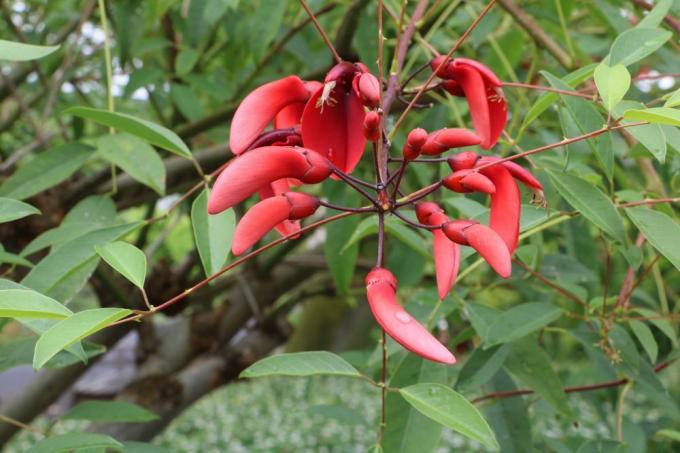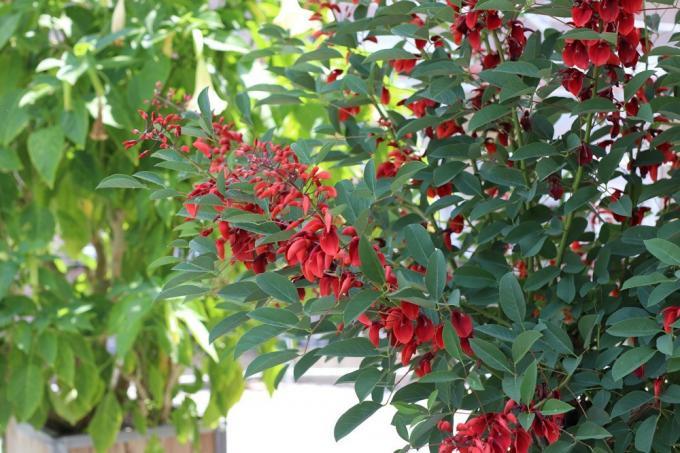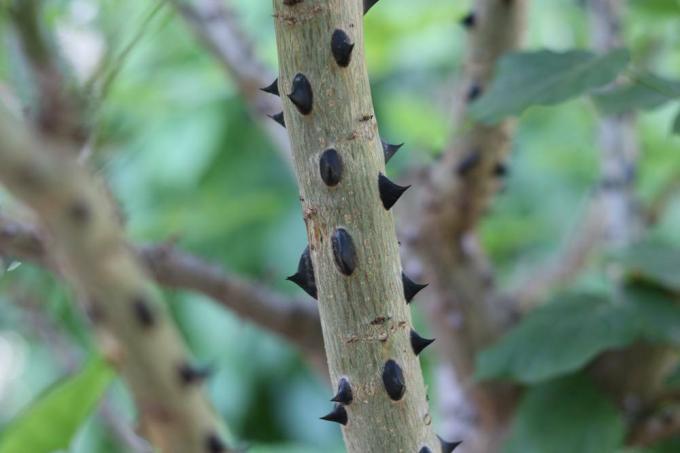
table of contents
- Characteristics
- Location
- Substrate
- care
- to water
- Fertilize
- Repot
- Cut
- Toxicity
- Overwinter
- Multiply
- Pests
Profile and care information open +conclude -
- Flower color
- Red
- Location
- Sunny, full sun
- Heyday
- July August September
- Growth habit
- Overhanging
- height
- up to 5 m high
- Soil type
- sandy
- Soil moisture
- moderately moist, fresh
- PH value
- neutral, slightly acidic
- Limescale tolerance
- Calcium tolerant
- humus
- rich in humus
- Poisonous
- Yes
- Plant families
- Legumes, Fabaceae
- Plant species
- Ornamental plants, potted plants, Potted plants
- Garden style
- Ornamental garden, roof garden, pot garden, rock garden
The coral tree impresses with its bright red flowers, which resemble a cockscomb, but are much larger. In Argentina it is revered as a national plant under the name Ceibo. The coral tree is still largely unknown in this country, although it does not make great demands on its care. However, he does need winter quarters, because the South American is not hardy.
Characteristics
- botanical name: Erythrina crista-galli
- Genus: Coral trees (Erythrina)
- belongs to the leguminous plant family (Fabaceae), subfamily butterflies (Faboideae)
- Common names: coral tree, cockscomb tree, common coral tree
- Height: 3 to 5 meters
- Growth habit: overhanging
- Leaves: tripartite, green
- Flower: red panicles
- Flowering period: July to September
- Origin: Argentina, Uruguay, Brazil and Paraguay
- perennial
- not hardy
- lime tolerant
- Location: sunny
- Soil type: sandy
- Soil moisture: fresh to moderately moist
- pH value: neutral to slightly acidic
- Humus: rich in humus
- Toxicity: highly toxic in all parts of the plant, including seeds
- Plant species: ornamental plant, roof garden, pot garden
- Garden style: solitary in the garden, larger rock gardens
Location

The coral tree originally comes from the subtropical and tropical regions of South America. Therefore it is not hardy and has to be cultivated in a bucket in this country. The location should be on the balcony or terrace
- warm
- full sun and
- sheltered from the wind
be. It is best to stand in a sunny corner, because the walls surrounding it give off heat and are also a protection on cooler spring nights. When the weather is good, the cockscomb tree spends the time outdoors from spring to September.
Substrate
Erythrina crista-galli makes no special demands on the substrate. It is important that it is slightly acidic. So humus-rich garden soil is completely sufficient for lush growth. Ideally the earth is:
- relaxed
- permeable
- slightly damp
- humus
Tip: To ensure that the soil is well drained, you can mix about 15 percent quartz sand into the substrate.
Buy preferred container plants
Coral trees are available from specialist retailers as pre-grown container plants. They are available in sizes from 40 centimeters to a good two meters.
care

Coral trees do not make great demands on care. They are also good entry-level plants for those who are new to potted plants. However, you have to be careful with the care of the plants, as they have thorns.
to water
Coral trees need regular watering during the growth phase. Water the plants moderately at the beginning of spring and increase the watering as they grow. From September you start to reduce the watering so that the plant can prepare for hibernation.
Tip: On very hot days in summer, you may well have to water the cockscomb tree in the morning and in the evening.
Even if coral trees are very thirsty, waterlogged or they do not tolerate wet feet. However, you can water them from below by filling the coaster with water.
Fertilize
In order for coral trees to develop well, they must be fertilized regularly. Fertilize the plants from mid-April to late August. During this time, they are given a serving of liquid fertilizer every seven to ten days. Alternatively, you can also use a slow release fertilizer. Here the first application of fertilizer takes place at the beginning of April and the second at the beginning of July.
Repot

Coral trees should be repotted every two to four years. The best time to repot is between March and May, before the plant is outdoors. So that it continues to grow well, the new pot should only be a little bigger than the old one. Make sure that the new tub has drainage holes and don't forget to create a drainage layer at the bottom of the planter.
Tip: When repotting, shorten the roots of the tree a little. In this way you branch out more strongly and take root better in the new substrate.
Cut
Coral trees are not evergreen plants and lose their leaves in autumn. In addition, the shoot tips of the coral tree dry up in autumn. This fact may frighten some hobby gardeners, but it is a natural process, even if it takes getting used to.
The ideal time to prune is in the spring, before the plant starts to bud. Only the older shoots are cut, as the flowers are developed on new shoots. If the plant has to be thinned, this can be done until the end of May.
Tip: Wilted flowers can be cut off throughout the outdoor season. This maintenance measure stimulates the flower formation.
Autumn cut
A strong pruning in autumn should only be done when the cockscomb tree no longer fits into the winter quarters. If the plant only needs to be reduced slightly, you can also carry out this cut in autumn.
Toxicity

Erythrina crista-galli is highly poisonous in all parts of the plant. The main active ingredients are isoquinoline alkaloids, which are said to have a similar effect to curare, the poison arrow.
Overwinter
The cockscomb tree is one of the easy-to-care for container plants, but you should do it before Consider purchase that he cannot spend the cold season outdoors and therefore a Needs winter quarters. Although coral trees can withstand light frost, they should still move to winter quarters at the end of September.
Dark wintering
Since the coral tree sheds its leaves after flowering, it can also overwinter in the dark. A basement with little light or a dark garage is suitable for wintering in the dark. It is important that the winter quarters are nice and cool, because after all they should keep the winter rest.
When wintering in the dark, it should be noted that the plant must slowly get used to the light again. That is why it must be placed in a bright, if possible cool, place in the apartment before it is cleared out.
Light wintering
Coral trees don't necessarily have to spend the winter in a dark cellar. You can also overwinter the plants in a cool conservatory or other bright room. Here, too, it has to be cool.
Regardless of how the coral tree has overwintered, it only comes out again when frosts are no longer to be expected. In this country, this is usually the case in mid-May after the ice saints. To clear it up, it is best to choose a cloudy day, because this sun worshiper also has to get used to the direct sun again.
Winter care
Since the coral tree should rest in winter, it must not be fertilized during this time. You should also hold back when watering. Only give it enough water to prevent it from drying out. Only when he comes back into light and warmth do you slowly increase the watering.
Multiply

Young coral trees can be grown from seeds or propagated by cuttings.
Seeds
When propagating with seeds you need a little patience, because the first flowers on the new coral tree only appear after about four years. However, the cultivation itself is easy.
- Let the bean-like seeds soak in lukewarm water overnight
- put in potting soil the next day
- Planting depth: 1 centimeter
- always keep slightly moist
In order for the seeds to germinate well, they need an ambient temperature of 20 to 25 degrees Celsius. Then you should see the first seedlings sprout after two to four weeks. You can prick out the small plants after another five to eight weeks.
Tip: The seeds of the coral tree are poisonous.
Cuttings
When propagating with cuttings, you can look forward to the blossoms on the new, young coral tree earlier. Cuttings are best taken in April, when the plant has freshly sprouted. Cut a cutting with three leaves below a knot. Then put it in a small pot with moist and loose soil. In order for the cutting to develop well, it needs
- a bright location without direct sunlight
- evenly warm temperatures over 20 degrees Celsius
Since high humidity promotes the growth of the cuttings, you can place it under a glass cover or cover it with a cover made of transparent plastic. With both variants, however, make sure that the hood or lintel do not come into contact with the cuttings. You should also ventilate the plant once a day. This prevents the formation of mold.
Pests
The best protection against pests is that the coral tree sheds its leaves in autumn. So can Pests it is difficult to implant in the long term. If it is very hot in summer, spider mites can attack Erythrina crista-galli. Aphids also like the plant. However, both pests are rare.
